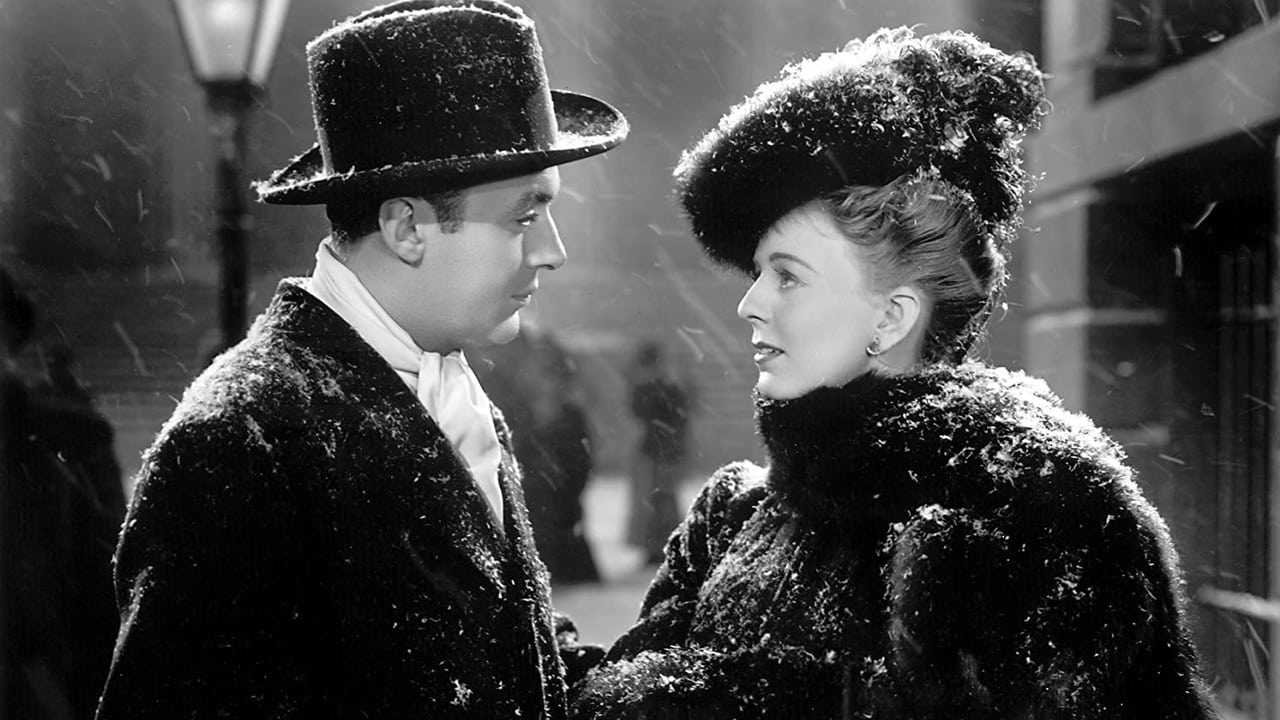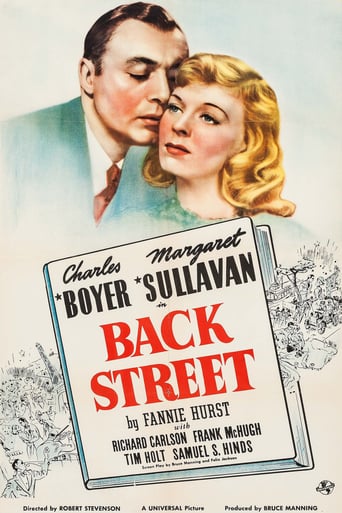lugonian
BACK STREET (Universal, 1941), directed by Robert Stevenson, is one of the finer love stories from the "soap opera" school that owes its success to the popular 1931 novel authored by Fannie Hurst. Initially produced by Universal in 1932 starring Irene Dunne and John Boles, this latest edition not only improves in style and performance from the earlier tearjerker, but simply indicates how "great movies are not made, they're remade." Usually whenever an original product gets redone, comparisons are usually made. There's no question that the Dunne and Boles romancer proved highly successful, but in contrast, this edition benefits greatly by its fine scripting by Bruce Manning and Felix Jackson, believable performances by Charles Boyer and Margaret Sullavan, and most of all, its impressive and sensitive scoring by Frank Skinner.Following the same pattern to the original, with few alterations along the way, the story gets underway in "Cincinnati, at the turn of the century" where Ray Smith (Margaret Sullavan) parades down the street with Curt Stanton (Richard Carlson), owner of a bicycle shop who later becomes an automobile manufacturer in Michigan. While Curt loves Ray and hopes to marry her, she very much prefers her carefree lifestyle and the company of various male suitors, especially Eddie Porter (Frank McHugh), a traveling salesman. While Ray bids Eddie farewell at the train station, he introduces her to Walter Louis Saxel (Charles Boyer), a Louisiana Frenchman and prominent New York banker arriving on a short stay before leaving on the next ferryboat. Not only do Ray and Walter become better acquainted within a few hours, but fall deeply in love. Having remained in town longer than expected, Walter makes arrangements to leave. Before he does, he confesses his engagement to marry and that they will never see each other again. The following morning, however, Walter, who cannot forget Ray, telephones her to meet him at the dock. Before her arrival, Walter makes preparations for a surprise wedding that's to take place on the boat between him and Ray. As Ray closes shop to meet Walter, situations occur preventing her from arriving at all. By the time she does gets there, she finds Walter gone and the ferryboat slowly disappearing from view. Five years pass. Ray, now a clothing designer in New York City, meets Walter again, now a prominent banker. Regardless of Walter now a married man with a son, the couple find they cannot live without each other. For the next 25 years (with its final chapter set in 1928), Ray lives the "back street" of Walter's life, passing herself off to others as his wife, Mrs. Raymond Smith. Problems take its toll as the middle-aged Ray is confronted by Walter's two grown children (Tim Holt and Nell O'Day). Having known of their father's illicit affair, they make ever effort of doing something about it.The basic premise to BACK STREET is "what if?" What if Ray were able to meet Walter at the dock and marry him as planned. Would their lives have been happier? Possibly so. Had it worked out that way, then there wouldn't have been the classic story of complications as we know it. Essentially a Sullavan film, it is Boyer whose name heads the cast of such notables as Esther Dale (Mrs. Smith, Ray's stepmother); Kitty O'Neil (Mrs. Dilling, the kindly landlady); Frank Jenks (Harry Niles); Samuel S. Hinds (Felix Darren); Nella Walker (Corinne Saxel, Walter's wife); Peggy Stewart (Freda, Ray's sister); Cecil Cunningham (Mrs. Miller) and Marjorie Gateson (Mrs. Adams). There's also surprise casting of cowboy actor Tim Holt playing Boyer's son, and a more or less straight performance by funster, Frank McHugh.Boyer, the romantic, is no stranger to motion picture love stories, with LOVE AFFAIR (RKO Radio, 1939) opposite Irene Dunne, being one of his best portrayals. However, his Walter Saxel is less sympathetic due to his selfishness for keeping both wife and mistress, and the way he takes Ray for granted. One such scene is evident as Walter spends an entire summer vacationing in Europe with his wife, with Ray waiting alone in her apartment for his letters that never come. Upon his return, days after the boat docks, Walter, without considering Ray's feelings, presents the news he's a father again. Ray, on the other hand, is strong willed except when it comes to Walter. Comparing the climatic showdown between father and son in both 1932 and 1941 editions, the soft-spoken Boles, best suited for faithful husband roles, presents himself as weak while Boyer's strong voice and forceful manner, especially when telling his son to mind his own business, is truly felt. Irene Dunne (Ray Schmidt) and Margaret Sullavan (Ray Smith), two different screen personalities, form their own interpretation of the same heroine, which works well on both levels for their performances.BACK STREET proved favorable viewing with its frequent TV broadcasts throughout much of the 1970s, especially on WOR, Channel 9's "Million Dollar Movie" in New York City. In an August 1975 showing, BACK STREET was given a special broadcast without commercial interruptions. Interestingly, however, only the third retelling of the story, the 1961 modern-dress/ Technicolor version starring Susan Hayward and John Gavin was made available onto home video in the 1990s. In 2011, both 1941 and 1961 versions to BACK STREET have become available on DVD package through Turner Home Entertainment. A pity there wasn't a triple feature using all three editions to the Fanny Hurst tearjerker. Cable television history to 1941's BACK STREET consisted that of American Movie Classics (1990-1998), sometimes on the double bill with the 1932 original, and Turner Classic Movie (TCM premiere July 19, 2001.) While Boyer and Sullavan worked together again, this time in a comedy titled APPOINTMENT FOR LOVE (Universal, 1941), it's this version of BACK STREET for which they will be remembered best. (***)
theowinthrop
This film (based on a Fanny Hurst best seller) is way out of date in the modern age. No self-respecting woman would be so willing to sacrifice her career for the prospect of being a millionaire's kept woman. No man, seriously in love with any woman, would put them through such a demeaning situation (they would consider divorce first of all, then remarriage). But there was supposed to be a sense of self-sacrifice by the heroine (Margaret Sullivan) that transcended the entire story.It is the acting that saves this film. Sullivan gives another of her touching performances, like THE SHOP AROUND THE CORNER and SING NO SAD SONGS FOR ME. Charles Boyer is as charming as ever, here as a potentially important banker who is going to marry his boss's daughter. Instead, he meets Sullivan and is captivated by her spirit and seeming independence. She has a number of male admirers (Frank McHugh and Frank Jenks among them). She's also something of a tease, leading on the others about dating them. Boyer and Sullivan gradually fall in love, but he is resigned (for ambitions sake) to marry the boss's daughter. But he sends word to Sullivan that if she will go to the steamboat landing where he is waiting, he would marry her despite his career. She gets the message, and tries to get to the landing. But she chooses to use Jenks as her "taxi driver", and he (recalling her promise to go with him for a jaunt into the woods), takes her miles in the opposite direction. When he hears her imploring him to turn around, and realizes that she has been teasing him all along, he tells her to get out of the buggy and walk back by herself. So she misses the steamboat, and Boyer (thinking she stood him up) leaves to marry the boss's daughter.Years later, after having developed a career as a designer, she meets the married Boyer again, and he convinces her to give up her career and become his mistress. Subsequently, despite warnings from her friend McHugh, and her other boyfriend Richard Carlston, she does not give up her relationship. It lasts until the end of their lives.All the performers are good. Among the minor performances note Tim Holt as Boyer's son who first reads Sullivan the riot act, but subsequently ends up sympathizing with her. Good cast and production, but the story is as dated as a dodo.
bayou52
I'm the rotten apple in the bunch. Everyone loved this version and blasted the 1961 super sudser. My comments will be brief. I just detested both of the main characters. Boyer's Saxel was a pompous boor at best and a downright t**d at worst. "Well, it's not as if I had a choice about taking this job!" paraphrase he exclaims haughtily when poor, poor Rae complains about his trip abroad. (Guess not...his father-in-law might have cut off his other... well, you know...and put it in his *other* jacket pocket) It was at about this point in the movie that someone needed to start slapping Rae about every 30 seconds or so. Someone called the Hayward version "unbelievable". That 1941-Rae would dump the oh so cute and sweet Curt in favor of that French aristocratic ass is the *height* of disbelief in my opinion. I mean, for crying out loud, Saxel not only left her for an indeterminate period of time but also took his wife with him, didn't tell Rae he was back for a week when he finally did come home and managed to pop off a baby girl Saxel with the little woman while on the boat. "You know how crazy everything gets when a new Saxel is born," <paraphrase> he tells her to excuse his tardiness (with an grudging "a"). Frankly, given his degree of romantic appeal, I'd have questioned paternity. Plot-wise, nobody is that stupid. But, Crazy Rae *still* leaves poor old Curt in the lurch to stand by her t**d. Now *that's* unbelievable. At least the Hayward character had the sense to get a job. In the 1961 version events were related pretty much as they happened...in this version, we are *finally* given an explanation of Rae's foolish devotion to Saxel (ah! now it all makes sense...well, no it doesn't) in so short a time that had I gotten up to yawn I'd have missed it. Saxel's lack of personality and superior attitude never was explained...chalk it up to a bad childhood in France. When the inevitable happened, I could only hope for lightning to hit the other end of the line. Well, I could go on but I won't. If ever a movie needed soaping, sudsing and completely dry cleaned it was this one and the 1961 Hayward/Gavin versions contained just the right brand of detergent. Put it on a hanger, slap it on the rack and tag it with a "00". I confess, in retaliation and outrage I voted the 1961 version a 10.

